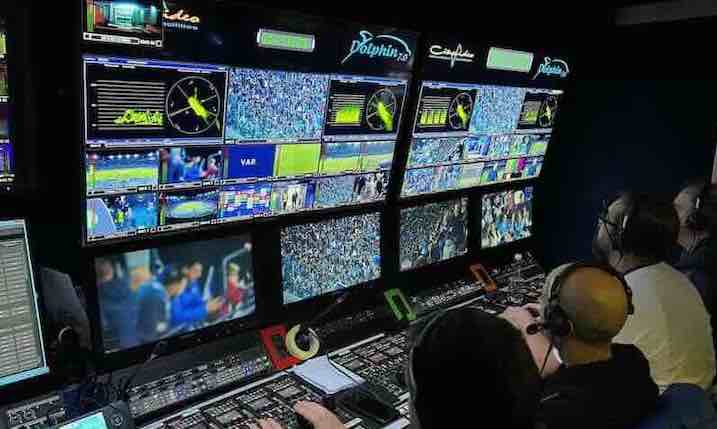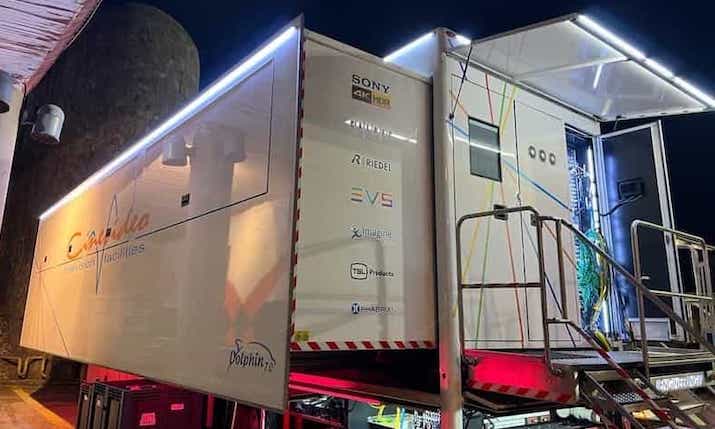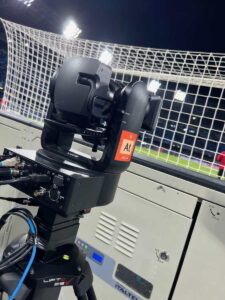UEFA Champions League: Cinevideo and Sky Italia opt for UHD HDR production

As Serie A club Napoli worked its way to the knockout stages of the UEFA Champions League, Sky Italia and Cinevideo took the opportunity to produce two of the team’s recent home matches in the tournament in native UHD HDR. The first was against Union Berlin in November, followed by Braga’s visit to the Maradona Stadium in December.
“These two games,” says Andrea Buonomo, executive sales manager, Cinevideo, “should be considered a real test of what will happen this year. In fact, it was essential to carry out concrete tests to ensure that everything would go smoothly and at the highest quality for UEFA and Sky.
“These were two important events because, in this season, no sporting event has been produced in UHD HDR in Italy.”
The UHD HDR (Ultra High Definition High Dynamic Range) television signal offers a superior visual experience with ultra-high resolution and an extended dynamic range. It provides more detailed images, more vivid colours and a wider range of brightness, significantly improving visual quality. It also offers an unparalleled level of realism and detail, making television viewing more engaging. It will become the standard for Champions League matches when the knockout stages resume in February.
As part of the tests, Cinevideo also incorporated HLG (Hybrid Log-Gamma), a standard for dynamic range designed to improve the quality of television images, particularly for high definition and ultra-high definition transmissions, into its workflow.

The Dolphin 7 OB was called into action for the games
Luciano Consigli, senior engineering manager at Sky Italia, states: “These were important tests carried out in anticipation of UEFA Euro 2024, which will be produced and broadcast in HDR. However, today’s SDR broadcasts ensure a very high-quality TV product and, in the transition to HDR production and transmission, this quality must be maintained.
“The HLG standard was created to ensure a smooth transition between SDR and HDR content, offering an optimised visual experience across a wide range of devices. This technology allows compatibility with more traditional devices to be maintained while providing a significant visual improvement with more vibrant colours, sharper details and a wider dynamic range.”
Accurate alignment
The production carried out by Cinevideo with a workflow entirely in UHD HDR required very accurate levels of alignment of all the devices involved. Everything must correspond to the required parameters and, above all, the conversion to SDR, which is derived from the UHD HDR program feed, must be absolutely perfect.
Today, the SDR signal still plays a very important role because Sky Italia broadcasts a 4K HDR signal but also maintains an SDR feed on sports channels. The same applies to UEFA, which receives the television signal and redistributes it to takers in SDR.
“This is not something trivial and should not be considered without due attention as the television production chain still includes some non-native HDR links,” continues Buonomo.
The Dolphin 7
Cinevideo utilised its Dolphin 7 OB truck, which already features an entire native UHD HDR technology production chain, including cameras and mixers in HLG-log, for the tests. Graphics were also provided in HDR by Deltatre.

Native UHD HDR PTZ cameras from Sony were used during the game against Union Berlin
There was, however, a need to add additional personnel within the mobile unit. Buonomo explains: “Due to the global distribution, which is still largely in SDR, the down-converted signal from the HDR production chain must be perfect. Therefore, it is necessary to add a new supervisor on board the mobile unit, who is defined as a colorist. They are responsible for quality control, and, through the visualisation of HDR and SDR monitors side by side, ensure that all signals are perfectly matched.”
Dolphin 7 employs Sony XVS 8000 mixers, HDC-4300 cameras, and HDRC 4000 production converters units, EVS replay systems, a Calrec Artemis console for audio production, and Riedel for communications.
In the first match, played in November, two native UHD HDR PTZ cameras from Sony, provided by Trans Audio Video, were tested, with mounted interchangeable cinematographic lenses. One was located in the players’ tunnel and one behind the goal.
The Dolphin has been configured for a typical dual production, with two on-board studios, the first to create the international host feed and the second to create the customised unilateral feed of Sky Italia.

